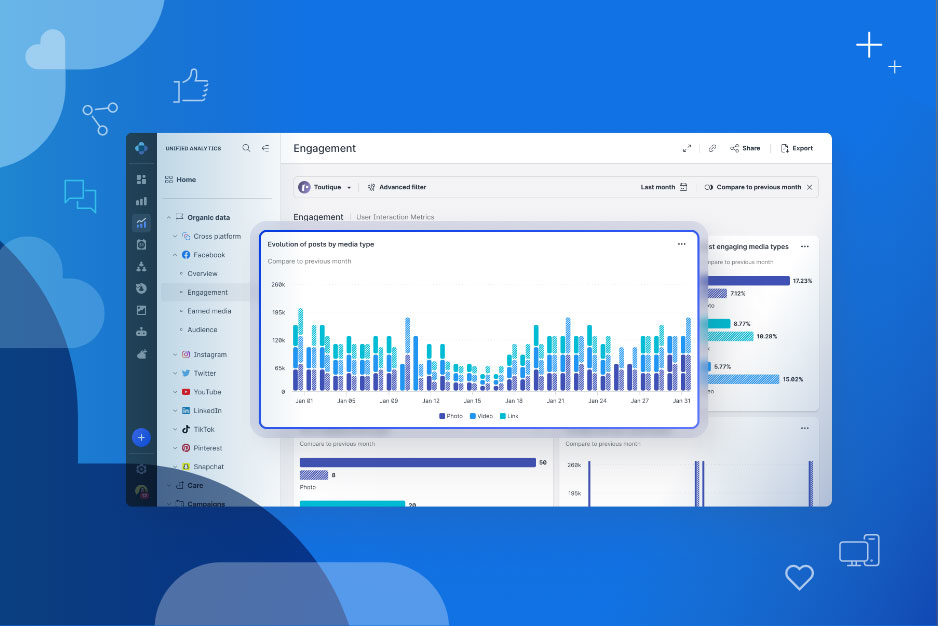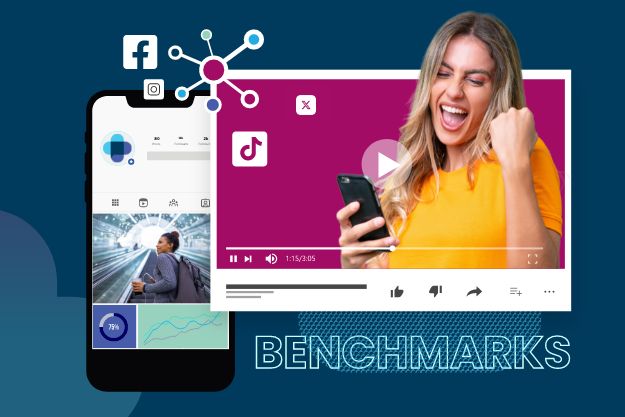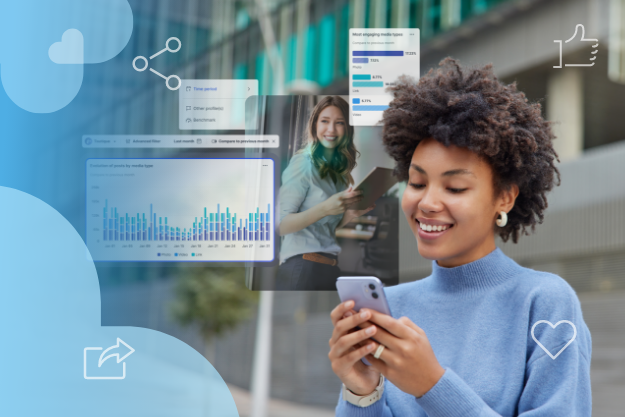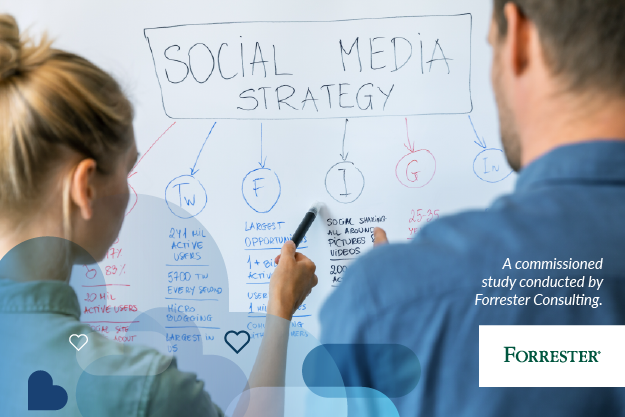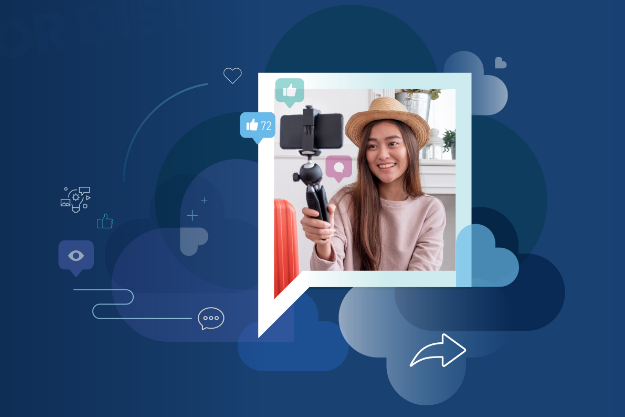Target audience analysis plays a crucial role in the success of digital marketing strategies. Understanding your audience is essential for creating meaningful connections with the people you are trying to reach.
As the modern consumer continues to evolve, your insights and understanding of the customer must keep pace. While agencies still have a role in audience analysis, digital marketing technology offers marketers the opportunity to gather valuable information independently.
Many marketers start with their own social media channels or anywhere you regularly interact with your audience. It’s key to start with what you know and then frame a strategy around what you don’t.
Let’s explore the importance of audience analysis, cost-cutting benefits, outperforming competitors, and delivering relevant content to customers.
What is audience analysis?
Audience analysis is the research of demographics, language, location, preferences, interests, and other metrics within a group. It is then analyzed to provide useful and actionable consumer insights for a brand in the form of buyer personas. These are semi-fictionalized profiles that are built from your target audience analysis.
There was a time when this kind of analysis was a painstaking and time-consuming process that all but required you to hire an agency to help you complete it if you wanted to be sure the information you were getting would be useful and properly sourced.
But the world has changed, and today’s consumers are sharing key details across digital channels through brand interactions, ratings and reviews, and even their own content to help you understand more about their needs.
The pace of campaigns has also ramped up, making it difficult to keep up with conventional methods. Thankfully, the age of digital and social media analytics has also made gathering the information you need more efficient.
The analytics tools we now have access to have sped up research and data collection significantly. What would have taken months of work before can be completed in a few clicks- whether it's data on your own audiences or if you’re keeping track of your competitors’ performance.
This isn’t to say agencies have been made obsolete. On the contrary, a combined approach can be the best method to collect as much valuable information about your audiences as possible.
On the other hand, agencies are always looking to keep up with client demands and deliver the best actionable data possible. With multiple clients running an increasing number of campaigns simultaneously, digital audience analysis seems the only way to go.
Here are some of the insights that an audience analysis can provide:
Demographics: Who are your target customers? What is their age, location, income level, education, occupation, and other key demographic information?
Psychographics: What are the attitudes, values, beliefs, interests, hobbies, and lifestyle choices of your target audience? What motivates and drives them?
Behaviors: What are the purchasing habits, buying preferences, and decision-making processes of your target customers? How frequently do they make purchases related to your products or services?
Channels: Where does your target audience spend their time online and offline? Which social media platforms, websites, blogs, or publications do they frequent? Do they prefer email, or are they more likely to engage through other channels?
Competitive analysis: How does your target audience engage with your competitors? What are the strengths and weaknesses of your competitors' marketing strategies when it comes to reaching and engaging with the target audience?
Pain points: What are the challenges, problems, or unmet needs that your target audience faces? How does your product or service address those pain points or fulfill their needs?
Customer satisfaction: How satisfied are your existing customers with your brand? What are their feedback, reviews, and testimonials? What aspects of your brand do they appreciate the most, and what areas need improvement?
Messaging: What language, tone, and style resonate with your target audience? How can you effectively share your brand message to engage and connect with them?
Brand perception: How do your target customers perceive your brand? What are their associations, perceptions, and emotions when they encounter your brand? Is your brand aligned with their values and preferences?
Customer journey: What are the different stages of the customer journey, from awareness to conversion and retention? What touchpoints and interactions are crucial for guiding them through each stage?
Why is audience analysis important?
Why should you be using audience analysis as the cornerstone of your marketing strategies?
You’re likely already familiar with the stages that make up the marketing funnel, although its form and structure are continually in debate (The funnel died to make way for the flywheel, which also died, bringing us back to the funnel).
The key is to understand that a buyer’s journey goes through some sort of stages, and agreeing what those look like are different for each audience and company. Broadly, they tend to fall into similar buckets to the following:
Awareness: Create brand awareness and attract attention.
Interest: Generate curiosity and capture potential customers' attention.
Consideration: Provide information and address concerns to facilitate evaluation.
Conversion: Turn interested prospects into paying customers.
Retention: Focus on customer satisfaction and encourage repeat business.
Advocacy: Leverage satisfied customers to promote your brand.
Each of these steps requires different kinds of content and timing, but what they share is a reliance on you understanding who your audiences are, where should you be reaching them – with what content, at what time, and how much will you have to spend to convert them?
To answer those questions, marketers rely on as much data as possible, and today’s consumers are typically happy to share or organically show your brand key data to fuel insights into your audience analysis. Investment into this type of research can offer deeper insights and calibrate each step of your buyer’s journey.
Here are some of the impacts of investment into this type of research:
Cut your costs and increase ROI
Marketing campaigns are trending toward a smaller scale and more personalized format. Keeping up with that trend and maintaining effective campaigns can be costly if not calibrated properly, and knowing your audiences and aligning your campaign content to them is the key to avoiding loss of ROI and increased costs.
McKinsey found that companies that use technology platforms to boost their customer experience see a 20-40% cost reduction. Additionally, marketers who utilize automation – which can return $5.44 for every dollar spent – can link these key customer details with a customer journey that offers the audience the right content at the right time and efficiencies for the teams managing your campaign.
You’ll save time and money by simply understanding more about the people your campaign is trying to reach, and those savings tend to scale dramatically – increasing revenue and retention by as much as 30% – based on how much you understand your audience.
Stay ahead of the competition
Blanket advertisement and poor targeting on social not only reduces the amount of leads and conversions you generate, but they also allow your competition to catch the customers you’re missing out on. Every audience is limited, so it’s important to focus on catching the attention of the people who will be most interested in what your brand has to offer.
Audience analysis can directly support personalization, which according to McKinsey, drives positive customer experiences while yielding a 20% increase in customer satisfaction and a 10-15% increase in conversion rates. Emplifi also discovered that 45% of modern consumers indicated they would “definitely buy from a brand again” when they receive authentic brand experiences. Another two-thirds of consumers surveyed by Message Gears suggested that a personalized customer experience meant a brand was “more likely to get their business.”
Pinning down what your ideal audiences look like and how to create personalized experience will go a long way in helping you attract people who will not only engage with your content and brand, but boost your conversions.
Delight your audience
There’s a problem in marketing: the symptoms lie in the gap between what marketers think they are doing and how customers feel about those same marketing efforts.
The Marketo Engagement Gap report puts this in clear numbers:
61% of marketers believe they engage with the right content.
56% of consumers believe businesses need to have a deeper understanding of their needs.
51% of consumers believe brands send too much irrelevant content.
One way to perceive this information is that currently, we as marketers are failing our customers by not reaching out to them in the right way, at the right time, with the right content. Another way to view it is as a major opportunity: if more than half of consumers feel that businesses don’t fully understand their needs, there’s a hole in the market for you to be one of the businesses that does.
To do that, you need to understand your audience inside and out. How well do they know your brand? How close are they to a buying decision? What are their motivations? You’ll need to gather whatever data you can at every level of your marketing funnel. To get the job done, you’ll need to bring in different tools.
The opportunity exists to do very well in business by understanding who your audiences really are.
Known and unknown audiences: What’s the difference?
Targeting audiences comes with a catalog of options for how to go about it and where to set your focus. This is where a somewhat new idea comes in: known and unknown audiences. Making the distinction between these can help you be more effective across the funnel and collect the right data to help you cut costs and improve targeting.
Known audiences are those you have had some kind of contact with already. They might have visited your site and used a free tool or signed up for a mailing list, giving you their email. They might have even made a purchase. Whichever way it happened, you have a unique trackable identification for that individual which you can then use for your remarketing efforts or for closing the customer experience gap.

On the other hand, unknown audiences are those you don’t have a lead or specific identifier for (yet!). Also in the category of unknown audience are people who match up with your current audiences, but who don’t know about your product. You know they’re out there, but they aren’t easily targeted. In attracting new customers, it’s up to you to target these unknown audiences effectively and successfully.
Cost-efficiency in the funnel
Conventional marketing wisdom tells us that it is around ten times more expensive to acquire and convert new leads than to reach out to people that have already been added to your CRM (Customer Relationship Management) tool. That is, it’s cheaper to operate your business at the lower end of the marketing funnel where people are closer to conversion than it is to focus on the top of the funnel where you would be developing awareness of your brand and acquiring new followers.
This, of course, has merit: the customers at the bottom of your funnel are already interested, and have either passed through the other steps already or simply entered lower in the funnel. But there are a couple caveats to this. Times, tech, and the tools you have access to as a marketer are constantly changing; so is the market.
Improving on convention
No matter what kind of business you are, it’s likely that the market is saturated to the point where it may not be about the bottom of the funnel, but rather the kind of experience you offer potential customers at the top of the funnel. This highlights why tactics like influencer marketing and brands utilizing user-generated content have become such successful marketing tools.
One of the main reasons that top-of-funnel marketing efforts tend to be more expensive is that businesses cast too wide a net. That is to say that they use top-of-the-funnel marketing in a more catch-all way, targeting mostly the right people, but also wasting resources on marketing to people for whom their content is irrelevant.
In order to make the top of the funnel efficient, you need to be reaching out to specifically targeted audiences you understand, with the content they are looking for in the places and times that they are online.
If you’re spending your budget on building awareness and interest in the wrong audiences, you won’t have many, if any, conversions. Yet, this highlights a method to make top-of-funnel marketing much more efficient and decrease its potential costs per new customer – by really knowing your audience throughout your marketing funnel and reaching out to the right people at the right time.
Remember: quality content is good, but the right content is even better.
So, now that you’ve made the decision to be more efficient, cut costs, and improve your audience analysis and targeting – where do you get the data for your audience research?
Where does your data come from?
Digital methods have left conventional data collection behind due to the sheer pace and scale at which data can be collected – especially at the top of the funnel. It’s good to have access to all the data you need – but where should you be getting it from?
Google Analytics and in-market segments
In-Market Audiences will show you users who are already active searching and comparing your brand to alternatives in the market. These are, in particular, people who might be interested in what your brand has to offer for a limited time.
A good example would be individuals who are currently looking to buy a car, or who are tourists looking for a hotel in a specific city. They have searched for options, compared possibilities, and maybe read up one some reviews – all indications that they are actively searching to make a purchase. More importantly, these actions are all tracked by Google.
With this information, you can consider how your brand can best position itself to reach out to this audience to grab their attention and show them that you have what they’re looking for.
Affinities
While In-Market Audiences look at fairly short-term prospects, Google Analytics also offers Affinity Audiences, which delves deeper into who your audiences are. It looks at a person’s lifestyle and interests to get a sense of their identity and habits.
These metrics help to develop an idea of a person’s general, long-standing interest. These can help you develop an idea of what people who like your product also like, which can in turn allow you to expand your reach.
Facebook Insights
Facebook Insights is, at its heart, a research and filtering platform allowing you to better understand and report on the audience and potential audiences of a Facebook page.
With page likes and self-reported information as the basis for its data, you can explore things in a range of informative metrics. You can view data on things like demographics, interests, page likes, and affinities, all of which will help you build a more complete picture of who your Facebook audiences are.
You can use it to see an overview of your Facebook audience or manually set up filters to segment your data to look at trends and characteristics within your audience.
Instagram Insights
Normal Instagram profiles don’t have access to analytics, beyond tracking likes and views for individual pieces of content yourself. The main Insights section you gain access to when you make the switch to an Instagram business account includes all the usual metrics on likes, follows, and impressions, along with data on profile visits, actions taken on your profile in general, and the reach of your account.
None of it is particularly in-depth, but Instagram does two things very well in terms of your audiences: social media engagement and influencers.
Influencer marketing has taken off and is now a mainstay in effective social media marketing strategy. There are a lot of reasons why you should embrace influencer marketing, but much of it boils down to the way consumers make decisions about what to purchase, with 86% of respondents stating that they take advice from their friends about making purchases. Influencers position themselves to pick up on this by functioning as amplified word of mouth.
Influencer campaigns have become a tour de force in social media marketing as an effective and flexible marketing option, you’ll want to incorporate them into your social media management efforts to get ahead of the game.
TikTok Insights
TikTok Insights is a powerful analytics tool that provides valuable data and insights about your TikTok audience and content performance. You can understand your audience demographics, track content performance metrics, analyze follower growth, and discover trends and hashtags relevant to your niche.
TikTok Insights offers audience demographics, including age, gender, location, and interests. This data helps you understand who your content resonates with and enables you to create more targeted and relevant content. You can track the performance of your TikTok content through metrics like views, likes, shares, and comments. This allows you to identify your most successful videos and replicate effective content strategies.
TikTok Insights provides data on follower growth over time. You can analyze the number of followers gained and lost, understand the impact of specific videos or campaigns, and identify trends in follower acquisition.
These insights also allow you to discover trending topics and hashtags in your niche or industry. By monitoring trends, you can create content that aligns with your audience's interests and increase your chances of gaining visibility and engagement.
Create a holistic view of your audience
Now that you've collected your data, it's sitting in PDFs, powerpoints, screenshots, a maybe if you're really old school you've even printed it out. How do you deal with this mess of information? How do you begin to see the bigger picture?
Consolidating your data isn’t something that native tools will allow you to do, but that’s where those third-party platforms and tools we mentioned earlier come in.
There are a few options for this, but the main goal here is to bring all your social media data into one place so you can view it holistically and really dive into the data. Once you have a full view of where you stand, you can get to work refining your content plan to more effectively engage with your audience.
Once you’ve consolidated your data, arrange it into buyer personas. If you need a little help creating these efficiently and accurately, you can turn to a buyer persona template, or use a tool for generating personas.
How target audience analysis benefits your marketing strategy
Personas are the tool, but the goal here is to make your target audience analysis data actionable. Here are 7 things you can do with Emplifi Social Marketing Cloud:
No. 1: You’ll lower your targeting costs significantly.
Studies show significant reductions in Facebook advertising costs with effective audience analysis, allowing you to save time and money in the long run.
No. 2: You'll improve ROI by converting easier and faster.
Knowing your audience’s affinities and behavior will help you target the right people at the right time to increase your Facebook relevance score.
No. 3: You'll be able to dive into influencer marketing with confidence.
Audience Analysis will allow you to pinpoint your own audience and find the right influencers to help your brand reach them.
No. 4: You'll know what content to produce and save money.
With quality audience analysis, you’ll understand where your audiences are in their customer journey. You’ll be able to distinguish between those who are ready to buy, and those who may need more time or awareness of your brand. All of which will help you organically, improve your SEO, and help to reduce your costs.
No. 5: You'll improve loyalty and retention.
Similarly to the points above, improving your knowledge of your audiences will help you reach out to them more authentically and personally. In this day and age, customers stick with brands they trust, and a big part of earning that trust is being able to speak to them in their language.
No. 6: You’ll be able to discover niche audience segments.
Your ideal audience might not be limited to the people you’re already working to target. Audience analysis can give you insight into niche segments, allowing you to reach out to groups that you may not even know exist yet.
No. 7: You’ll gain a competitive edge.
In an oversaturated market, getting leads is a race against your competition. With clearly defined audience personas, you can get an edge that will allow you to overtake the competition trying to target the same audience.
With all these benefits and more from quality, cross-platform target audience analysis, what are you waiting for?














